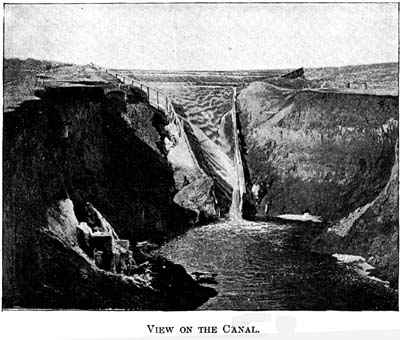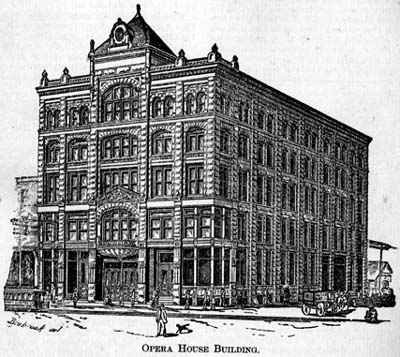
| 96 |
NEBRASKA'S ENTERPRISING CITIES.
|
graduates. The social life of the city is found very attractive by new-comers. The race track of the Buffalo County Agricultural Association is within two miles of the business center, and the spring and fall meetings are events drawing horsemen from a wide circuit. Sportsmen find an abundance of game in this section. In season, thousands of ducks and geese feed along the Platte and Wood Rivers. Quail, prairie chickens and snipe abound on the prairies. Rabbit coursing and wolf hunts afford rare sport, dogs and horses especially trained, adding to the excitement of the chase.
PUBLIC LIBRARY.--A Free Public Library, located in rooms in the new City Hall building, is maintained by the city, circulating a creditable number of volumes of standard literature. Reading rooms in connection contain the leading newspapers and periodicals on file, accessible daily. The library is liberally patronized
NEWSPAPERS.--The city has two dailies, evening and morning, four weeklies, a church and school monthly, and telegraph franchise.
BANKS.--Four national banks transact Kearney's general banking business. Their condition as reported to the comptroller of currency was as follows March 1, 1892: Capital paid in, $500,000: surplus, $116,000; loans and discounts, $1,042,815; deposits, $685.004; undivided profits, $31,236. One State bank and one savings bank bring the total number of banks up to six.
HOMES.--In 1890, the city had 1,520 houses, 637 of which had been added within two years. Many have been erected since, though the greater part of the building of late has been in

the direction of business and factory structures. The hotel facilities are adequate and include a handsome fireproof structure. (There are only seven saloons in Kearney, or less than one for every thousand inhabitants.)
The character of our homes is amply shown in the accompanying illustrations.
COST of LIVING.--Dwelling houses may be rented in the most desirable portions of the city at prices ranging from ten dollars per month, for five or six-room cottage, upward, with electric street car convenience at hand. Small houses in some sections may be had as low as six dollars per month. Water rates are reasonable. Electric light service is lower than in any city in the West. A house requiring sixteen-candle power lights may enjoy a freedom from dirt, and danger from fire, and a perfect light for less than one cent per lamp each night. Gas rates are also low. Excellent markets supply meats and vegetables at prices enabling families to live better and cheaper than in a majority of eastern cities.
SANITATION.--Kearney is 2,200 feet above the sea. One of the first acts of Kearney, on becoming a city, was to construct an adequate system of sewers. There are now laid twelve and one-half miles of sewer mains, sufficient to meet the demands of a city of 40,000 people. This improvement was completed in 1890, at a cost of $70,000. The death rate for the year is less than one per cent, of the population. The city owns the cemetery, and this very low percentage may be verified from the city sexton's reports.
RAINFALL.--A local authority gives the rain
|
KEARNEY
|
97
|
fall at Kearney, for 1889, at thirty-one and a half inches. and snowfall at eight and three-fourths inches. The United States Signal Service reports give the average for twenty years, at Fort Kearney, at 25.42 inches. Charts by the same authority also show that this section of the Platte Valley has a greater rainfall than some other sections about us. The Signal Service Bureau has recently establishes a fully equipped observation station here, and complete reports and records will be furnished in future from this station.
POSTAL FACILITIES.--Kearney enjoys the benefits of free delivery of mail matter. The net profit to the government from the office during 1800 was $8,328. The business of the office entitles the city to a government building, which will doubtless be granted in the near future.
TELEPHONE EXCHANGE.--Business in the city is facilitated by an excellent telephone exchange with 200 subscribers. The management is in good hands and the service gives general satisfaction.
FIRE PROTECTION.--The city fire department is equipped with all the latest apparatus for fighting fire. The pressure of the city water system obviates the use of steam fire engines. One hundred and sixty fire hydrants disposed about the corporation limits answer all requirements, while 3 000 feet of hose allow a large section to be surrounded and a fire fought from many points at one time. The efficiency

of the department affords a low rate of insurance, The city council has recently let the contract for an electric fire alarm system, and intends shortly to add a chemical engine to its appliances. One of the volunteer fire companies holds the State championship for speed.
RAILROADS.--Kearney is an important station on the main line of the Union Pacific, with over six miles of side track. The depot has recently been completed at a cost of $25,000. The Burlington makes Kearney the western terminus of one of its Nebraska branches, and affords the city the finest connections to and from the East, to and from which it handles the bulk of the business. Aided by these roads and the Kearney & Black Hills Railway, recently built sixty-six miles into the fertile territory to the northwest and soon to be extended into the Black Hills and Wyoming, Kearney commands a large jobbing trade in the rapidly growing regions to the west and northwest.
Additional carrying facilities will be furnished us in the near future by the building of the Missouri Pacific, already in operation to within twenty-six miles of Kearney to the southeast. This will connect Kearney directly with St. Louis and the southeastern markets. The building of forty miles of road will give us the Chicago & North Western, with its network of main line and branches to the east and northeast.
Other old roads expected are the Chicago, Rock Island & Pacific, and the Chicago, Mil-
|
© 2002 for the NEGenWeb Project by Pam Rietsch, Ted & Carole Miller |
||